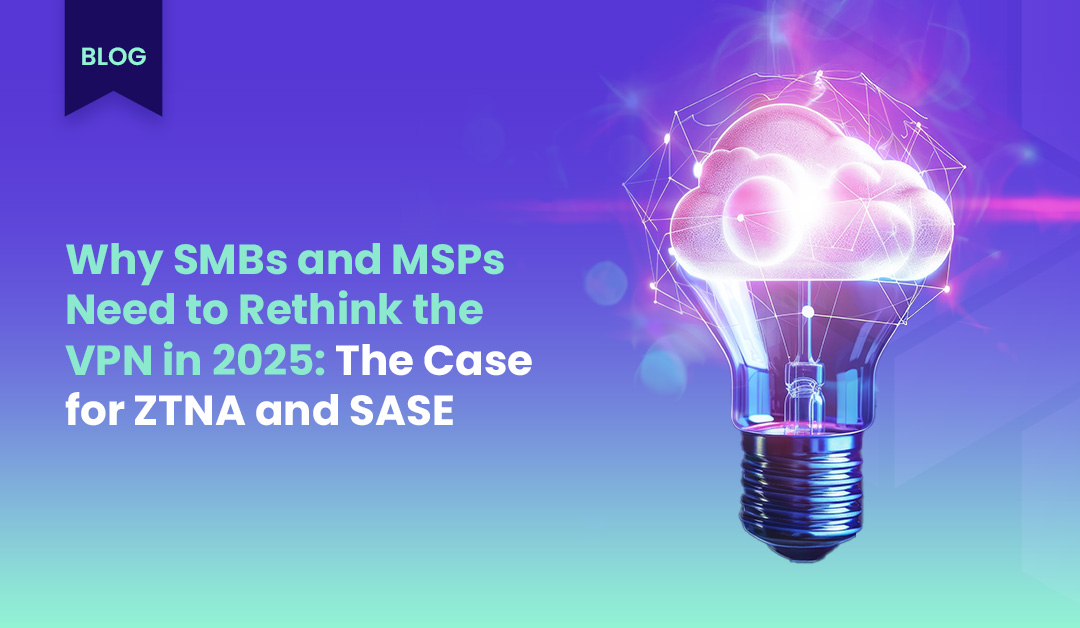Why SMBs and MSPs Need to Rethink the VPN in 2025: The Case for ZTNA and SASE
Is your SMB still relying on firewalls and VPNs to secure data? Learn why these tools are no longer enough and discover how SASE can minimize business risks and provide modern, cloud-based security for your distributed team.
Author
Date
Category
All Categories
- AI-powered security
- Attacks & Threats
- Cybersecurity
- Hybrid Cloud
- Network
- Network Firewall
- Network Protection
- News
- Remote Workforce
- Security
- Zero Trust
Contents
Popular Posts
Product
Join the Newsletter

In 2025, small and mid-sized businesses (SMBs) and their managed service providers (MSPs) are being pushed to face an uncomfortable truth: the traditional VPN just isn’t cutting it anymore. Between ransomware targeting remote users, compliance headaches, and sprawling SaaS apps, the need for simple, secure, and scalable access is more urgent than ever.
That’s why more MSPs are moving away from the legacy business VPN model and embracing Zero Trust Network Access (ZTNA) and Secure Access Service Edge (SASE). If you’re still relying on static IP VPNs or “always-on VPN” solutions to secure access for your team or your clients, it’s time to explore a better alternative—one built for the modern workforce.
Let’s unpack the trends, technologies, and tactical shifts happening in the MSP SASE and ZTNA MSP space—and how vendors like Timus are simplifying secure access for SaaS, web, and cloud.
VPNs Weren’t Built for Today’s Threat Landscape
The original idea behind VPNs was to extend a private corporate network into the homes of remote users. In the 2000s, it worked. But today, with SaaS-first work, device diversity, and hybrid workforces, VPNs are struggling to adapt.
Here’s what’s wrong with most VPNs used by SMBs:
- Always-on VPN creates a flat network where one compromised device can become a lateral threat.
- Static IP VPN solutions create predictable targets for attackers.
- Traditional VPNs don’t perform device posture checks—so even an infected laptop gets in.
- They’re blind to what users do once they’re connected: whether they’re accessing Salesforce or opening an RDP port.
Cybercriminals know this. According to incident response reports, RDP security breaches and VPN compromises are among the top root causes of MSP ransomware incidents.
So why are we still clinging to VPNs?
ZTNA: Secure by Default, Built for MSPs
ZTNA (Zero Trust Network Access) flips the VPN model on its head. Instead of giving users network access and hoping they’re trustworthy, ZTNA assumes no one—and no device—is trusted by default.
It’s:
- Application-specific (not network-wide)
- Enforced with continuous checks like device posture, geo, risk level
- Integrated with identity, policy engines, and context-aware rules
For MSPs managing 5, 50, or 500 tenants, ZTNA offers a modular, scalable, and simple network security layer without backhauling all traffic through a data center.
And when ZTNA is bundled into a broader SASE solution for MSPs, it becomes even more powerful.
SASE: The convergence of Networking and Security
SASE (Secure Access Service Edge) isn’t just a buzzword—it’s a strategic response to how modern IT operates.
It combines:
- ZTNA for secure remote access
- Cloud VPN for site-to-site and branch connectivity
- Secure Web Gateway (SWG) for URL filtering, malware scanning
- Cloud Firewall for application-layer protection
- Static or dedicated IPs to protect SaaS applications behind the IP
Solutions like Timus SASE deliver all of this in a SaaS-native platform designed for MSPs. You can provide secure SaaS access control, enforce data protection, and offer tenants per-user policies in a single dashboard—no hardware and maintenance required.
What MSPs Get with a True VPN Alternative
If you’re an MSP looking for a VPN alternative, or a better way to meet client demands without a patchwork of legacy tech, here’s what a purpose-built SASE platform gives you:
| Feature | Legacy VPN | ZTNA + SASE (Timus) |
| Static IP | ✅ | ✅ (Dedicated IP) |
| Application-level access | ❌ | ✅ |
| Device posture check | ❌ | ✅ |
| Cloud firewall | ❌ | ✅ |
| Secure SaaS access control | ❌ | ✅ |
| Always-on with dynamic policy | ❌ | ✅ |
| Multi-tenant dashboard | ❌ | ✅ |
| Built for MSPs | ❌ | ✅ |
With Timus, you also gain access to tools that make client onboarding painless and policy management automatic—crucial for small IT teams juggling multiple SMB clients.
Why This Matters for SMBs
SMBs are increasingly being held to the same standards as enterprises—especially when it comes to cyber insurance compliance. Insurers are asking about:
- MFA enforcement
- RDP and VPN access controls
- Endpoint protection and posture visibility
- Segmented network access
With ZTNA and SASE solutions built for SMBs, you meet those requirements without enterprise overhead. You also minimize the risk of a ransomware outbreak jumping from a compromised intern laptop into your finance systems.
More importantly, you simplify secure access across:
- SaaS platforms like Microsoft 365, Salesforce, Notion
- Legacy apps hosted in AWS or Azure
- RDP connections that need to be exposed but controlled
- Internal admin panels or ERP systems
With a business VPN alternative like Timus, you get zero-trust policies, dedicated IPs, posture enforcement, and more—without hiring a security architect.
What About SaaS App Access Control?
SaaS sprawl is real. Your clients are using 30–50 apps across teams. Each one with different logins, roles, and risks.
With Timus’ integrated ZTNA VPN, you can:
- Gate SaaS apps behind identity and device checks
- Restrict access to sanctioned apps only
- Stop data exfiltration via unmanaged browsers or shadow IT
- Monitor usage per app and enforce policy dynamically
This kind of SaaS security is critical to protecting SMBs without burdening end users.
The Bottom Line
The VPN is no longer the gold standard. It’s a liability.
SMBs and MSPs need scalable, modern tools that prioritize least-privilege access, constant verification, and cloud-delivered enforcement. ZTNA and SASE aren’t just buzzwords—they’re the backbone of secure, flexible access in 2025 and beyond.
If you’re an MSP offering static IP VPNs or cobbled-together firewall appliances, it’s time to upgrade. If you’re an SMB relying on old-school VPNs to protect your cloud-first business, there’s a better way.
Timus is built for MSPs, designed for SMBs, and architected for the realities of the modern workforce. It’s time to move beyond VPNs—and into the era of simple, scalable zero trust security.
Want to Learn More?
- Beyond the Firewall and VPNs: The Ultimate SMB Guide to Securing Data
- What Is Zero Trust and Why It Matters to SMBs
- How Timus SASE Protects Against Cyberthreats
FAQ
A modern VPN alternative for MSPs and SMBs is a cloud-native solution like Zero Trust Network Access (ZTNA) or SASE. These technologies provide secure, application-specific access without giving users full network visibility—unlike traditional VPNs. Platforms like Timus also include cloud firewalls, device posture checks, and secure SaaS access control, making them ideal for businesses seeking simple network security that scales.
ZTNA only grants access to the specific applications or services a user needs, and only after verifying identity, device posture, and risk level. This contrasts with always-on VPNs, which tunnel all traffic into the network and assume trust once connected—an outdated model that exposes SMBs to RDP security threats and lateral movement in ransomware attacks.
MSPs benefit from SASE solutions because they offer consolidated security and networking capabilities—like ZTNA VPN, cloud VPN, secure web gateways, and dedicated static IPs—in a single SaaS platform. Vendors like Timus make it easy to manage multiple tenants, meet cyber insurance compliance, and replace legacy stacks with a more scalable, cloud-first model.
Absolutely. SASE platforms like Timus allow MSPs and SMBs to enforce SaaS security policies, such as which users can access which apps, from which devices, and under what conditions. This reduces shadow IT risk, prevents data leaks, and ensures consistent policy enforcement across tools like Microsoft 365, Salesforce, and more.
Instead of exposing RDP ports through static IP VPNs, use ZTNA with device posture checks to restrict access. With Timus, for example, MSPs can set rules that only allow RDP connections from compliant devices with updated antivirus, disk encryption, and Windows security enabled—blocking potential ransomware entry points.
Get Started with Timus
Zero Trust. Adaptive Cloud Firewall. Secure Remote Access. In one.
